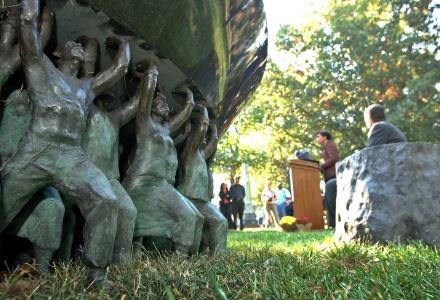

This series of events, classes and speakers examined how the human rights abuses of the past influenced the present and can be harnessed toward social justice in the future. A project of the Duke Human Rights Center@the Franklin Humanities Institute and the Pauli Murray Project, Dangerous Memories took as one starting point the words of Durham daughter Pauli Murray, who urges us to accept “the whole past” and derive strength from all of our roots and face up “to the degradation as well as the dignity” of our ancestors.
What does that mean in practice? In countries like South Africa, Chile, Hungary, the United Kingdom’s Northern Ireland, Germany and Cambodia among others, that means grappling with difficult pasts in a way that promotes discussion and supports reforms that protect human rights. We also brought these questions directly to the Duke campus, which we’re treating as a laboratory to ask questions about how we remember and memorialize the past and what changes might open up a more inclusive discussion of the university’s roots.
When asked recently how Duke could work to dismantle oppression in North Carolina and Durham, #BlackLivesMatter founder Patrisse Cullors offered a blunt response. “You would need to cease to exist… Institutions like Duke were built on the backs of anti-black racism, the genocide of indigenous people.”

Cullers’ challenge goes beyond metaphor and is deeply grounded in the bricks and mortar of campus. On West, founder James B. Duke stands for an enlightened capitalism built within a structure of violent white supremacy. On East, his father, Washington Duke, sits comfortably in a chair whose brass fringe might just have been cleaned by the family slave. The trustees recently approved the removal of the Robert E. Lee statue from the Chapel as well as segregationist North Carolina governor Charles Aycock’s name from a Duke dormitory. But the History Department building still honors Julian S. Carr, whose segregationist views were publicly aired at the 1913 dedication of the University of North Carolina’s “Silent Sam” statue. To the audience, Carr publicly boasted that he’d performed a “pleasing duty” when he “horse-whipped a negro wench until her skirts hung in shreds, because upon the streets of this quiet village she had publicly insulted and maligned a Southern lady.”
To be sure, a few locations on campus reflect a more complex past. During anti-apartheid protests in 1986, Duke sophomore Susan Cook replied to a Chronicle letter to the editor by citing the architectural work done by her great granduncle, Julian Abele, a black man. Abele designed the Duke’s Manhattan mansion, then was tapped to provide the overall design for their new university in Durham. The university later installed a portrait of Abele in the Allen building.

Unsung Founders memorial at the University of North Carolina-Chapel Hill
However, these additions remain little more than tokens. Other universities are well ahead of Duke, among them UNC-Chapel Hill, the University of Mississippi and Brown. UNC-Chapel Hill installed “Unsung Founders” in 2005, acknowledging the role enslaved peoples played in the construction of the campus. At the University of Mississippi, a statue of James Meredith, who integrated the campus in 1962, now marks the entrance to the Oxford campus.
In 2003, Brown University created a Steering Committee on Slavery and Justice that prepared a report about the University’s historical relationship to slavery and the transatlantic slave trade. Among the recommendations was the installation of a memorial acknowledging the university’s ties to the slave trade The university unveiled the memorial in conjunction with the school’s 250th anniversary. Designed by Martin Puryear, the two-part memorial includes a partially buried ball and chain and a stone plinth with engraved text. The sculpture complements curriculum for Brown and K-12 students, a public acknowledgement of the university’s ties and investments in the Providence community.
However, it’s worth noting that most universities have yet to engage in a deep examination and public acknowledgement of their history. In this sense, Duke could be among the leaders in this area, fostering a deep and broad rethinking of the past and a positive plan for establishing a fuller account of its history
In 2016-2017, DHRC@FHI faculty and staff delved into Duke history and how it is reflected on campus. In a project supported by Bass Connections and the Archives Alive! project at the Rubenstein Rare Books and Manuscripts Library, we completed a thorough review of existing sites, creating the first-ever digital map of memory sites at Duke, including statues, plaques, named sites and portraits. In addition, students worked with the University Archives to create a story bank of moments in Duke’s history that should be commemorated in a physical way. Students also designed their own sites, including one that commemorates the 1968 “Silent Vigil” as well as the first women and African Americans to graduate from and teach at the University.
Our final report, with recommendations on how to expand and deepen Duke’s memory map, create orientation and campus tours, and proposed proposed stories to embody, will be released in April 2018, in conjunction with the 50th anniversary of the “Silent Vigil.”